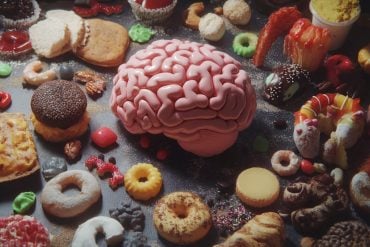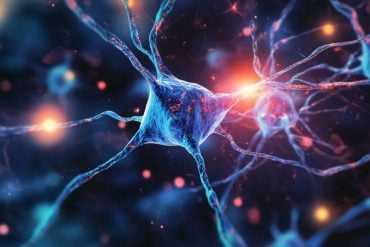Summary: A new study reveals people who experience larger dips in blood sugar hours after eating end up feeling hungrier and eat hundreds of more calories a day than those who experience lower blood sugar dips.
Source: King’s College London
New research shows that people who experience big dips in blood sugar levels, several hours after eating, end up feeling hungrier and consuming hundreds more calories during the day than others.
A study published today in Nature Metabolism, from PREDICT, the largest ongoing nutritional research program in the world that looks at responses to food in real life settings, the research team from King’s College London and health science company ZOE (including scientists from Harvard Medical School, Harvard T.H. Chan School of Public Health, Massachusetts General Hospital, the University of Nottingham, Leeds University, and Lund University in Sweden) found why some people struggle to lose weight, even on calorie-controlled diets, and highlight the importance of understanding personal metabolism when it comes to diet and health.
The research team collected detailed data about blood sugar responses and other markers of health from 1,070 people after eating standardized breakfasts and freely chosen meals over a two-week period, adding up to more than 8,000 breakfasts and 70,000 meals in total.
The standard breakfasts were based on muffins containing the same amount of calories but varying in composition in terms of carbohydrates, protein, fat and fiber. Participants also carried out a fasting blood sugar response test (oral glucose tolerance test), to measure how well their body processes sugar.
Participants wore stick-on continuous glucose monitors (CGMs) to measure their blood sugar levels over the entire duration of the study, as well as a wearable device to monitor activity and sleep. They also recorded levels of hunger and alertness using a phone app, along with exactly when and what they ate over the day.
Previous studies looking at blood sugar after eating have focused on the way that levels rise and fall in the first two hours after a meal, known as a blood sugar peak. However, after analyzing the data, the PREDICT team noticed that some people experienced significant ‘sugar dips’ 2-4 hours after this initial peak, where their blood sugar levels fell rapidly below baseline before coming back up.
Big dippers had a 9% increase in hunger, and waited around half an hour less, on average, before their next meal than little dippers, even though they ate exactly the same meals.
Big dippers also ate 75 more calories in the 3-4 hours after breakfast and around 312 calories more over the whole day than little dippers. This kind of pattern could potentially turn into 20 pounds of weight gain over a year.
Dr. Sarah Berry from King’s College London said, “It has long been suspected that blood sugar levels play an important role in controlling hunger, but the results from previous studies have been inconclusive. We’ve now shown that sugar dips are a better predictor of hunger and subsequent calorie intake than the initial blood sugar peak response after eating, changing how we think about the relationship between blood sugar levels and the food we eat.”
Professor Ana Valdes from the School of Medicine at the University of Nottingham, who led the study team, said: “Many people struggle to lose weight and keep it off, and just a few hundred extra calories every day can add up to several pounds of weight gain over a year. Our discovery that the size of sugar dips after eating has such a big impact on hunger and appetite has great potential for helping people understand and control their weight and long-term health.”
Comparing what happens when participants eat the same test meals revealed large variations in blood sugar responses between people. The researchers also found no correlation between age, bodyweight or BMI and being a big or little dipper, although males had slightly larger dips than females on average.
There was also some variability in the size of the dips experienced by each person in response to eating the same meals on different days, suggesting that whether you’re a dipper or not depends on individual differences in metabolism, as well as the day-to-day effects of meal choices and activity levels.

Choosing foods that work together with your unique biology could help people feel fuller for longer and eat less overall.
Lead author on the study, Patrick Wyatt from ZOE, notes, “This study shows how wearable technology can provide valuable insights to help people understand their unique biology and take control of their nutrition and health. By demonstrating the importance of sugar dips, our study paves the way for data-driven, personalized guidance for those seeking to manage their hunger and calorie intake in a way that works with rather than against their body.”
Tim Spector, Professor of Genetic Epidemiology at King’s College London and scientific co-founder of ZOE, concludes, “Food is complex and humans are complicated, but our research is finally starting to open up the black box between diet and health. We’re excited to have been able to turn this cutting-edge science into an at-home nutrition and microbiome test so that everyone has the opportunity to discover their unique responses to food to best support their metabolism and gut health.”
About this metabolism research news
Source: King’s College London
Contact: Press Office – King’s College London
Image: The image is in the public domain
Original Research: Closed access.
“Postprandial glycaemic dips predict appetite and energy intake in healthy individuals” by Wyatt, P., Berry, S.E., Finlayson, G. et al. Nature Metabolism
Abstract
Postprandial glycaemic dips predict appetite and energy intake in healthy individuals
Understanding how to modulate appetite in humans is key to developing successful weight loss interventions.
Here, we showed that postprandial glucose dips 2–3 h after a meal are a better predictor of postprandial self-reported hunger and subsequent energy intake than peak glucose at 0–2 h and glucose incremental area under the blood glucose curve at 0–2 h. We explore the links among postprandial glucose, appetite and subsequent energy intake in 1,070 participants from a UK exploratory and US validation cohort, who consumed 8,624 standardized meals followed by 71,715 ad libitum meals, using continuous glucose monitors to record postprandial glycaemia.
For participants eating each of the standardized meals, the average postprandial glucose dip at 2–3 h relative to baseline level predicted an increase in hunger at 2–3 h (r = 0.16, P < 0.001), shorter time until next meal (r = −0.14, P < 0.001), greater energy intake at 3–4 h (r = 0.19, P < 0.001) and greater energy intake at 24 h (r = 0.27, P < 0.001). Results were directionally consistent in the US validation cohort.
These data provide a quantitative assessment of the relevance of postprandial glycaemia in appetite and energy intake modulation.







